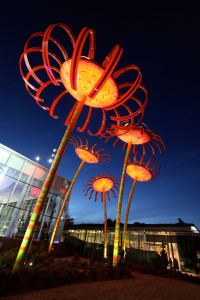3D Printing the Sonic Bloom

Last week a 3rd grade teacher (Ms. Klingel) popped into my classroom and told me she had an idea for a lesson. She was wondering if I would be willing to help incorporate 3D printing into the lesson. After a few minutes of figuring out what she wanted to do we had an idea for one of the best STEAM (Science, Technology, Engineering, Art, and Mathematics) lesson’s that I have ever taught. In fact, I liked it so much that I decided to do the project with my 4th graders as well.
Image Credit: Dan Corson
The project centers around an art exhibit in Seattle, Washington called “Sonic Bloom“. Seattle artist Dan Corson created giant singing flowers that absorb the sun’s energy all day and glow at night. They are spectacular, and I hope to see them in person some day.
It is the perfect project to inspire a classroom that is learning all about energy, electricity, and 3D printing. The students will be reading an article that describe the Sonic Bloom, then they will be creating their own mini version.
I began this project by creating my own model. There are many factors that need to be worked out. Ms. Klingel and I started talking about what materials we would need. We settled on using twisty ties that we have for math manipulatives for the the petals, the top of a small Slurpee, pipe cleaners for decoration and for a path for electricity, the solar panel from a Dollar Store solar walkway light, a blinky LED, and a 3D printed stem.
The file was created in 123D Design from Autodesk. This was the first time we have used this program.
I assigned two of my students the task of learning how to design the stem and the base. I decided to try and use Autodesk’s 123D Design software. It was easy to download and there were several tutorials online to help us figure out how to use it. It took us a couple of days, but we were able to come up with a prototype. Of course that didn’t work, so 3 prototypes later we were printing.
The decision was made to use the prototype for the third grade class, and my students who worked on the prototype will teach the other students in the class how to make their own. Then we will print theirs and use their own design in their models.
Creating the stem and a working prototype. It stills needs the flower part.
Ms. Klingel and I have made a working version. We were really excited when the solar panel lit up the LED. Her class will start the project next week. Mine will get started on making their stems next week. I’m hoping that my class will start the design process early next week. It will take us about a week to get all of our stems designed, and another week to get them all printed. Then we can start making our circuits and flowers. You’ll have to stay tuned to see how they turn out.
Source: 3D Printing the Sonic Bloom





Leave a Reply